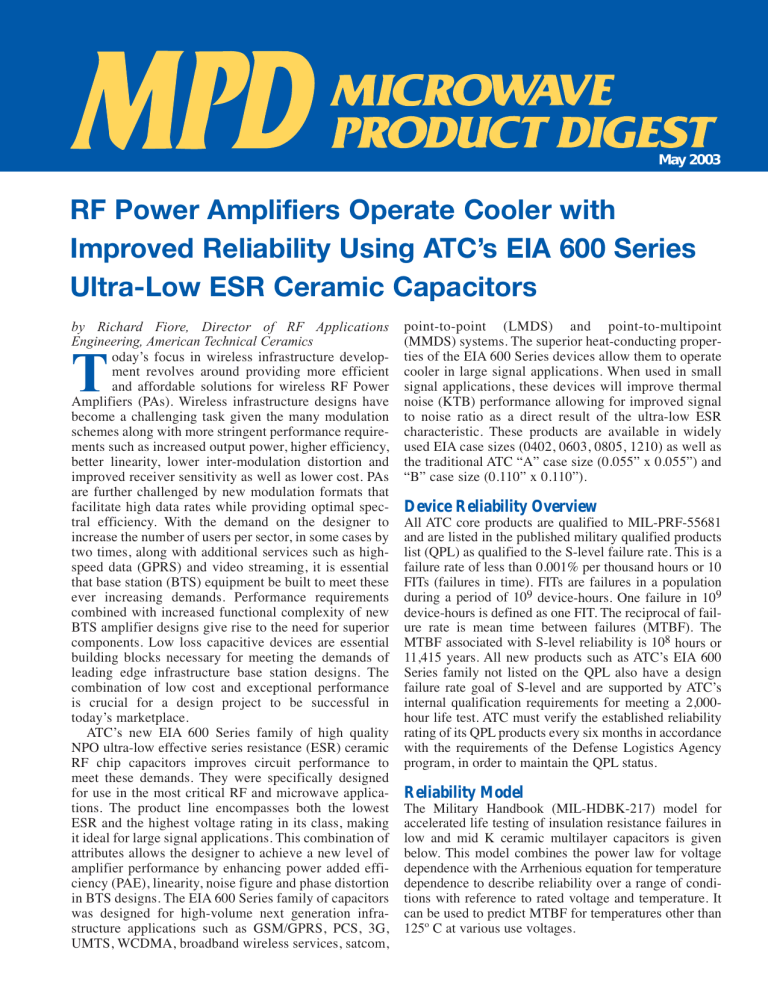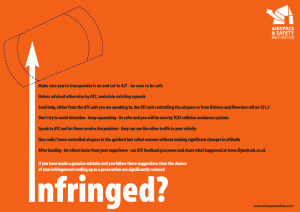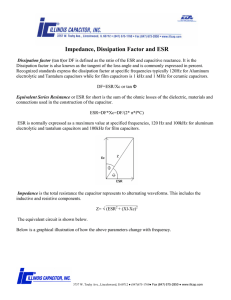
May 2003
RF Power Amplifiers Operate Cooler with
Improved Reliability Using ATC’s EIA 600 Series
Ultra-Low ESR Ceramic Capacitors
by Richard Fiore, Director of RF Applications
Engineering, American Technical Ceramics
oday’s focus in wireless infrastructure development revolves around providing more efficient
and affordable solutions for wireless RF Power
Amplifiers (PAs). Wireless infrastructure designs have
become a challenging task given the many modulation
schemes along with more stringent performance requirements such as increased output power, higher efficiency,
better linearity, lower inter-modulation distortion and
improved receiver sensitivity as well as lower cost. PAs
are further challenged by new modulation formats that
facilitate high data rates while providing optimal spectral efficiency. With the demand on the designer to
increase the number of users per sector, in some cases by
two times, along with additional services such as highspeed data (GPRS) and video streaming, it is essential
that base station (BTS) equipment be built to meet these
ever increasing demands. Performance requirements
combined with increased functional complexity of new
BTS amplifier designs give rise to the need for superior
components. Low loss capacitive devices are essential
building blocks necessary for meeting the demands of
leading edge infrastructure base station designs. The
combination of low cost and exceptional performance
is crucial for a design project to be successful in
today’s marketplace.
ATC’s new EIA 600 Series family of high quality
NPO ultra-low effective series resistance (ESR) ceramic
RF chip capacitors improves circuit performance to
meet these demands. They were specifically designed
for use in the most critical RF and microwave applications. The product line encompasses both the lowest
ESR and the highest voltage rating in its class, making
it ideal for large signal applications. This combination of
attributes allows the designer to achieve a new level of
amplifier performance by enhancing power added efficiency (PAE), linearity, noise figure and phase distortion
in BTS designs. The EIA 600 Series family of capacitors
was designed for high-volume next generation infrastructure applications such as GSM/GPRS, PCS, 3G,
UMTS, WCDMA, broadband wireless services, satcom,
T
point-to-point (LMDS) and point-to-multipoint
(MMDS) systems. The superior heat-conducting properties of the EIA 600 Series devices allow them to operate
cooler in large signal applications. When used in small
signal applications, these devices will improve thermal
noise (KTB) performance allowing for improved signal
to noise ratio as a direct result of the ultra-low ESR
characteristic. These products are available in widely
used EIA case sizes (0402, 0603, 0805, 1210) as well as
the traditional ATC “A” case size (0.055” x 0.055”) and
“B” case size (0.110” x 0.110”).
Device Reliability Overview
All ATC core products are qualified to MIL-PRF-55681
and are listed in the published military qualified products
list (QPL) as qualified to the S-level failure rate. This is a
failure rate of less than 0.001% per thousand hours or 10
FITs (failures in time). FITs are failures in a population
during a period of 109 device-hours. One failure in 109
device-hours is defined as one FIT. The reciprocal of failure rate is mean time between failures (MTBF). The
MTBF associated with S-level reliability is 108 hours or
11,415 years. All new products such as ATC’s EIA 600
Series family not listed on the QPL also have a design
failure rate goal of S-level and are supported by ATC’s
internal qualification requirements for meeting a 2,000hour life test. ATC must verify the established reliability
rating of its QPL products every six months in accordance
with the requirements of the Defense Logistics Agency
program, in order to maintain the QPL status.
Reliability Model
The Military Handbook (MIL-HDBK-217) model for
accelerated life testing of insulation resistance failures in
low and mid K ceramic multilayer capacitors is given
below. This model combines the power law for voltage
dependence with the Arrhenious equation for temperature
dependence to describe reliability over a range of conditions with reference to rated voltage and temperature. It
can be used to predict MTBF for temperatures other than
125º C at various use voltages.
MAY 2003
MICROWAVE PRODUCT DIGEST
V1
Rated
Voltage
V2
Acceleration
Voltage
T1
Standard Test
Temp. 125º C
T2
Accelerated
Temp. (º C)
Accelerated
Factor
150
150
125
125
1
150
75
125
125
0.125
8 x 108
150
200
125
125
2.370
0.42 x 108
MTBF
(Hours)
108
Table 1: Reliability at Various Voltages and Temperatures
Where:
t1 =
t2 =
V1 =
V2 =
T1 =
T2 =
n =
Ea =
K =
MTBF associated with the rated condition
MTBF associated with the test condition
rated voltage
test voltage (2 x WVDC) or any accelerated
or decelerated voltage or use voltage
max. rated temperature in degrees Kelvin (125º C
+ 273.14) = 398.14º K for ceramic capacitors
accelerated or decelerated temperature in
degrees Kelvin (º C + 273.14) or use temperature
voltage stress exponent normally accepted to
be 3 from the cube power rule referenced
in MIL-HDBK-217
the temperature activation energy, established
to be 1.0 eV for ceramic capacitors and is
accepted as the predominant conduction
mechanism below 300º C
Boltzmann’s constant (8.617 x 10-5 eV / ºK)
The above model is associated with the mobility of
oxygen vacancies in the lattice structure of low and mid K
ceramics while under a voltage stress. The use of this
model in relationship to analysis of insulation resistance
degradation in a ceramic capacitor assumes that the failure mechanism results from the increased mobility of
these oxygen vacancies.
Reliability is defined relative to the reference conditions– in this case rated voltage at maximum rated temperature for the device under test. Burn-in and life testing
represent accelerated tests relative to the rated conditions.
These tests typically take place at 125º C and twice-rated
voltage as outlined in MIL-PRF-55681. Using n=3 in the
power law portion of the equation will yield an acceleration factor of 8x rated (2n = 23 = 8).
The same model can be used to extrapolate reliability
to other voltage and temperature conditions that are both
accelerated or decelerated. For a given capacitor with a
voltage rating of 150 WVDC, the reliability at various
voltages and temperatures could be established by applying the equation in the above model as outlined in Table 1.
From this an acceleration factor can be calculated. This is
the factor by which the MTBF will change from the reference. In the table the first row shows an acceleration
factor of 1, which is associated with rated conditions. As
the voltage or temperature is changed from the rated conditions, the MTBF will be altered by the acceleration factor. Table 1 gives examples of acceleration factor as a
function of various voltages and temperatures.
The MTBF of the accelerated or decelerated condition
will be equal to the initial MTBF divided by the acceleration factor. For example, if the applied voltage is equal to
the rated voltage and the temperature is increased from
the maximum rated 125º C to 135º C, the MTBF is cut
approximately in half.
Performance Advantages
The advantages of ATC’s EIA 600 Series ultra-low ESR
capacitors can be immediately seen in the performance of
PA matching, coupling/DC blocking and bypass applications. Many benefits such as providing design margin,
improving production yields, and cutting unwanted thermal rise while increasing reliability are achieved by using
ultra-low ESR capacitors in various circuit applications.
In addition the bill of material (BOM) costs are reduced.
Reduce BOM Costs and Circuit Complexity
in Coupling Applications
Amplifier designers are always looking for cost effective
approaches to reduce passive circuit losses. Today’s multistage feed-forward and pre-distortion approaches are
limited by the capacitors that are used. Interstage coupling
losses can quickly add up. By using ATC’s EIA 600
Series ultra-low ESR capacitors, several tenths of a dB of
gain per stage in the signal path is readily recaptured.
This allows the designer the latitude of using smaller RF
MAY 2003
semiconductor die sizes. The RF semiconductor devices are the single largest
cost driver in an RF power amplifier
design. This cost benefit can be realized
with as little as three gain stages in a PA
circuit path. Figure 1, illustrates a
power amplifier lineup consisting of
multiple cascaded gain stages with
interstage coupling capacitors and their
associated ESR losses. The cumulative
insertion loss is equal to the summation
of the individual insertion losses of
each coupling capacitor (IL1 + IL2 +
IL3 +
ILN). The insertion loss is
largely a function of the capacitor’s
ESR losses. Therefore, a lower ESR
will yield lower end-to-end insertion
loss and higher effective gain.
MICROWAVE PRODUCT DIGEST
...
Figure 1: Typical Power Amplifier Lineup
Provide Necessary Design Margin and
Improved Yields in Matching Networks
ATC’s EIA 600 Series ultra-low ESR capacitors afford the
designer better matching network performance. In addition, manufacturing operations will realize improved
product yields, while reducing development design iterations. In matching applications the shunt capacitor closest
to the active device plane is the most critical since it will
sink the largest amount of current. An ultra-low ESR
capacitor will increase both the efficiency and the effectiveness of the match, providing accurate and repeatable
circulating current flow from module to module. The
effects of mechanical component placement or skewing
become less of a variant in this scenario, resulting in
improved manufacturing yields. This is known as “lock-
down effect” in matching network circuit design. These
devices provide excellent performance repeatability and
will therefore unburden the criticality of component
placement alignment on the board during the manufacturing process. Allowing the capacitor to ‘take up the slack’
from board dielectric tolerances and skewing effects will
minimize rework and the need for tuning, resulting in
increased yield. This in turn will reduce the number of
rejected amplifier modules in any given production lot.
Figure 2 illustrates a PA output matching circuit.
Capacitor CM is illustrated with its ESR loss. Parasitic
inductances LP1 and LP2 are associated with the physical
matching of the capacitor’s termination profile and the
microstrip line width. The mismatch between the capacitor’s terminations and the microstrip line width will disturb the characteristic shunt impedance, ZO =
L/
C
Reduce Unwanted Thermal
Rise While Increasing Product
Reliability
Figure 2: Critical Capacitor match in PA Output Module
ATC’s EIA 600 Series will allow PAs to
operate cooler while increasing reliability. For example, code division multiple
access (CDMA) and wideband CDMA
(WCDMA) systems require a multi-carrier PA that must exhibit extreme linearity. These base station PA modules are
usually operated as class A or AB. In
these configurations the amplifier typically operates with an 8 to 12 dB peak to
average power ratio. For instance, a
25W WCDMA BTS PA is required to
have a peak power of about 250W,
while maintaining the required linearity
levels of - 45 dBc per the 3GPP standard. Using 600 Series capacitors in the
match will optimize linearity, and provide
increased headroom, while providing
MAY 2003
MICROWAVE PRODUCT DIGEST
better thermal performance
resulting in higher reliability.
Thermal management and reliability become major factors as
these designs typically generate a large amount of heat,
which can easily affect module reliability. A case study
follows.
Thermal Comparison
between ATC 600S
and Brand A
A comparison between ATC’s
600S Series (EIA 0603 case
size) RF chip capacitors and a
competitor’s High-Q EIA
0805 SMT, to be referred to as
Brand A showed that the overall performance of 600S series
capacitors is notably better.
Both the 600S and Brand A
capacitors were tested and
compared in an actual 2 GHz
power amplifier application
by an impartial third party.
The unit under test was a 2
GHz power amplifier module
using a single Motorola
MRF21125, LDMOS transistor. The outcome of this A/B
comparison test illustrates that
ATC’s 600S (EIA 0603 size)
capacitors operate cooler than
the competitor’s larger EIA0805
size High-Q capacitor in the
same application. (See Figures
3 and 4)
Figure 3: Thermal Scan of Test Board Using Brand A Capacitors
Figure 4: Thermal Scan of Test Board Using 600S ATC Capacitors
Infrared Scan of the
MRF21125 RF Device
The following test details were provided by Motorola
Development Engineering.
Motorola performed infrared (IR) scans on a
UMTS Power Amplifier test module in order to characterize the thermal performance of its MRF21125
LDMOS device and associated matching and coupling circuitry. A worst-case operational test scenario
was implemented for this study. ATC’s 600S and
Brand A capacitors were tested separately using the
same test board and under the same test conditions
Figure 6 is a photo of the actual test module.
Test 1 - PA test module with Brand A, EIA 0805 size
capacitors, fan voltage at 8 V (minimum fan speed)
Test 2 - PA test module with ATC 600S EIA0603
size capacitors, fan voltage at 8 V (minimum fan
speed)
Test Setup:
RF output power = 22 W,
Frequency = 2.14 GHz
Modulation = WCDMA
Drain voltage = 27 V
Active Device = MRF21125
Bias current = 1.3 A
MAY 2003
MICROWAVE PRODUCT DIGEST
Note 1: Module was painted
black using Plasti Dip spray
paint, to provide a uniform
emissivity
Note 2: Module was mounted on a finned heat sink
Test Results
Table 2 shows a summary of
the operating temperatures
of the 600S (EIA 0603 size)
and the EIA 0805 Brand A
devices under the same test
conditions. From the data
collected it can be seen that
the low capacitance 600S
Figure 5: Thermal Map showing location of various parts and PC
samples in the matching netBoard artwork.
work (C62, C63 and C64)
appear to be thermally
equivalent, if not slightly
better, than the Brand A
devices. Large thermal contributions from the transistor
in proximity to C62, C63
and C64 may explain the relatively higher constant
device temperatures measured in this region.
However, it is interesting to
note that the 18 pF DC
blocking / coupling capacitor designated as C57 is
about 6 degrees centigrade
cooler than the Brand A
device. Since the coupling
capacitor experiences the
full output power of the
amplifier, it will dissipate
power in direct proportion to
its ESR (PCD = I2 ESR). The
lower operating temperature
of the 600S is attributed to Figure 6: Actual PA Test Board
the fact that the 600 series
capacitors exhibit a lower ESR than that of Brand A. because it couples the full output power of the
At 2 GHz the ESR of the ATC 600S180 (18pF) capac- amplifier to the load. In addition C57 is mounted far
itor is typically 0.08 ohms, while the 18 pF Brand A enough away from the transistor, which is the main
capacitor exhibits about 0.18 ohms, more than 200 heat contributor, such that the thermal effects of the
percent higher. The thermal scan data below illus- transistor could be essentially isolated and not overtrates a significant difference in temperature between shadow the heating effects of the subject capacitor.
both products. (See Figures 3, 4 and 5).
The measured temperature of the 600S C57 was
49.2º C. In comparison the temperature of the 18 pF
Brand A device is 55º C which is approximately 6º C
Test Conclusion
The thermal scans above clearly show that the higher. From the thermal scans it can be seen that the
600S180 (18 pF) C57 output coupling capacitor did EIA 0805 Brand A capacitor significantly connot significantly contribute to the thermal rise of this tributes to the thermal rise of this module.
module. C57 was selected for this discussion
MAY 2003
• ATC 600S (C57)
operates 6 degree
cooler than Brand A in
the same application.
• The ESR @ 2 GHz for
ATC’s 600S -18 pF is
0.08 ohm as compared to
0.185 ohm for the
Brand A -18 pF
capacitor. The ATC
600S exhibits
less than half the ESR as
compared to Brand A.
MICROWAVE PRODUCT DIGEST
Part
C62,
C64,
C63,
C57,
1 pF
1 pF
1.2 pF
18 pF
Brand A (0805)
Temp. (º C)
55.6
55.7
55
55
ATC 600S (0603)
Temp. (º C)
54.5
54.2
54.3
49.2
Table 2: Summary of Capacitor vs. Temperature Under
Operating Condition
• The ESR @ 2 GHz for ATC’s 600S -1 pF is 0.11 ohm
compared to 0.3 ohm for Brand A 1 pF capacitor
@ 1 GHz. The ATC 600S -1 pF exhibits
approximately one third the ESR @ 2 GHz as
compared to Brand A @ 1 GHz.
• Reduces thermal noise (KTB) and improves signal to
noise ratio (SNR) in receiver applications
The 600 Series Advantage
Conclusion
• Lower Operating temperature in power amplifier
applications
This article discussed clear performance advantages associated with using ATC’s ultra-low ESR EIA 600 Series
capacitor products. The main performance attributes of
capacitive components used in design projects are frequently a trade-off to cost. The 600 Series family has been
designed to provide excellent RF performance along with
cost and reliability advantages, giving the designer a competitive edge in today’s marketplace. ATC offers technical
applications support for their entire range of products.
• Higher power handling due to ultra-low ESR
• Better volumetric efficiency; affords real estate
savings
• Highest voltage rating in class for greater design
margin
• Improves rejection floor and selectivity characteristics
in filters
• Improves PA reliability by operating cooler
• Ideal for critical matching lock down
• Reduces insertion loss in coupling applications
Sales of ATC products are subject to the terms and conditions contained in American Technical Ceramics Corp. Terms and Conditions of Sale(ATC document #001-992 Rev. B 12/05). Copies
of these terms and conditions will be provided upon request. They may also be viewed on ATC's website at www.atceramics.com/productfinder/default.asp. Click on the link for Terms
and Conditions of Sale.
ATC has made every effort to have this information as accurate as possible. However, no responsibility is assumed by ATC for its use, nor for any infringements of rights of third parties which
may result from its use. ATC reserves the right to revise the content or modify its product without prior notice.
© 2003 American Technical Ceramics Corp. All Rights Reserved.
ATC # 001-985 Rev. C; 4/05


